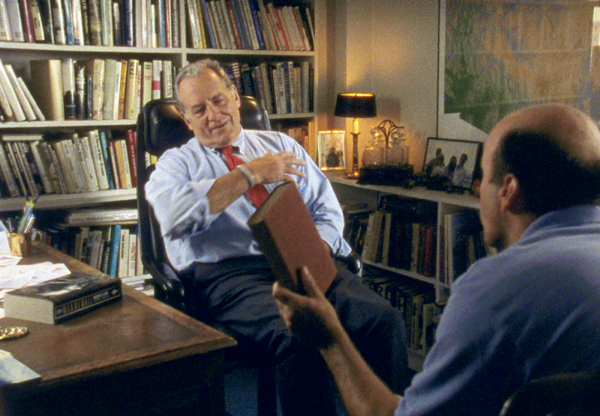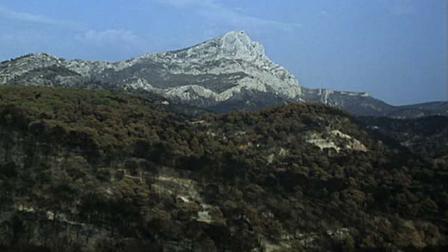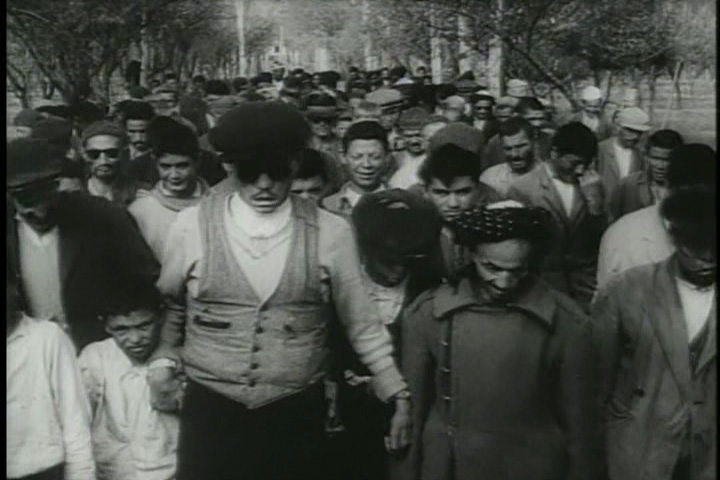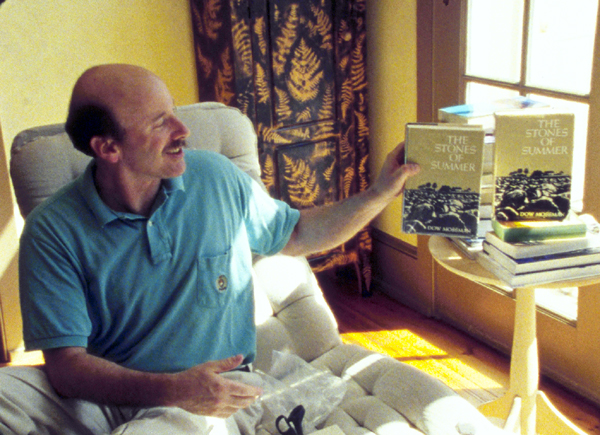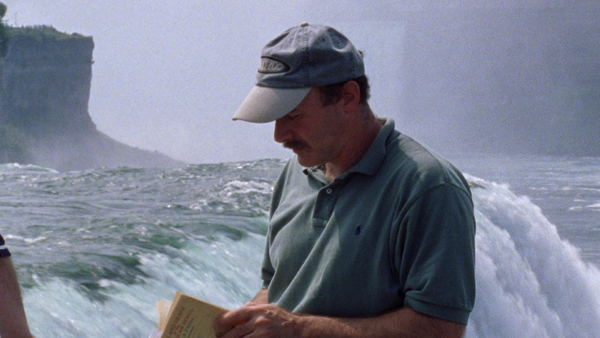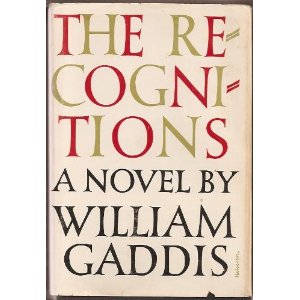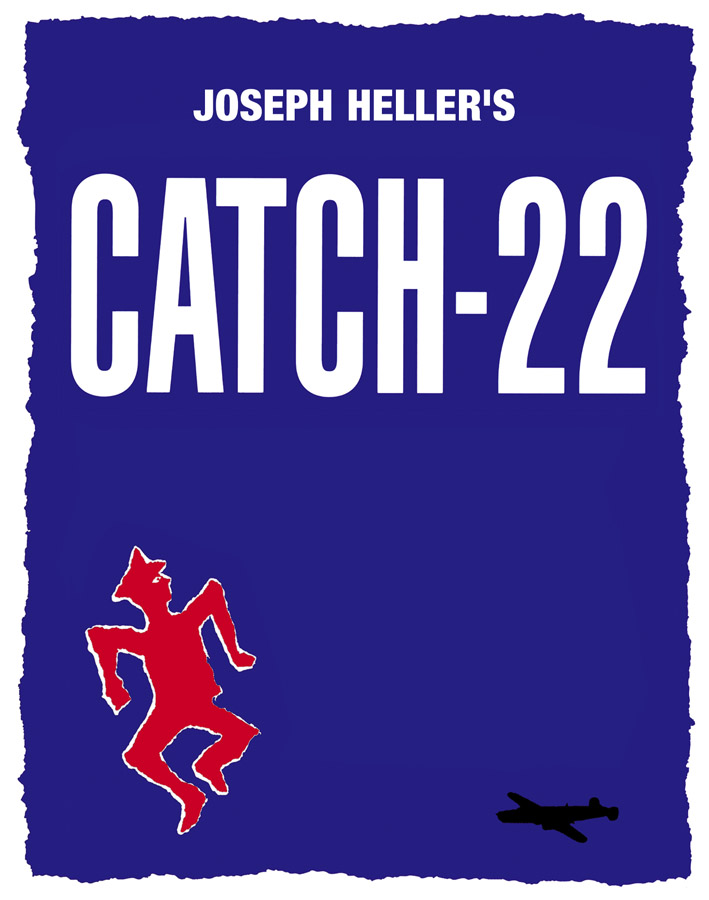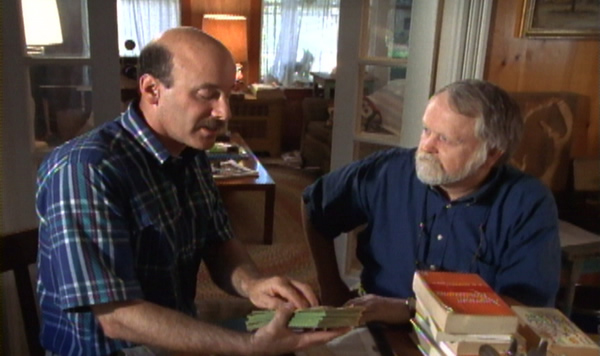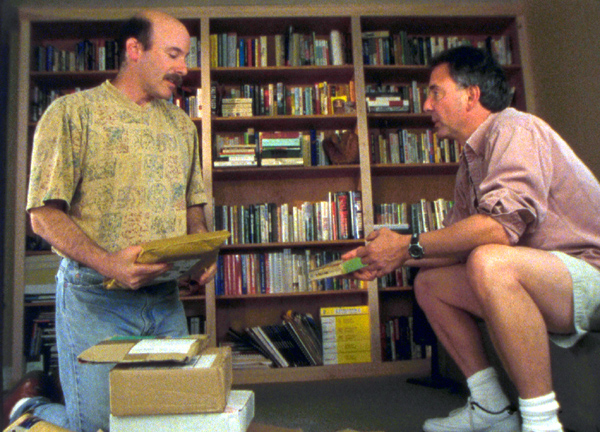From the Chicago Reader (July 18, 2003). — J.R.
Stone Reader
*** (A must-see)
Directed and written by Mark Moskowitz.
Cinema has traditionally been regarded as the art that encompasses all the other arts. But start considering how successfully cinema encompasses any particular art form and the premise falls apart.
Filmed theater, opera, ballet, and musical performance omit the existential and communal links between performer and audience that their live equivalents rely on. Paintings can be filmed, but films that allow us even some of the freedom viewers have in galleries, museums, and other public and private spaces are rare enough to seem like aberrations. Jean-Marie Straub and Danièle Huillet’s 1989 Cézanne [see above] — which has the nerve to give us extended views of Cézanne canvases from fixed camera positions — has never been screened publicly in this country because the filmmakers refuse to let it be subtitled, knowing that subtitles would impede our view of the paintings. The more common procedures of cutting between details or panning and tracking across a picture impose itineraries that wouldn’t necessarily be our own.
The same problem is apparent in films of sculpture and architecture. In the case of literature, which clearly provides cinema with more material than any of the other arts, the incompatibility is even more acute. Poetry poses the greatest number of obstacles, and one reason I cherish Forough Farrokhzad’s 21-minute Iranian documentary The House Is Black (see above, 1962) is that it manages to merge poetry and cinema without compromising or diluting either. Short stories and novels are more adaptable, yet the experiences of reading a work of fiction and of seeing a film remain radically different and on some level irreconcilable.
These reflections were prompted by Stone Reader, a fascinating and compulsively watchable personal documentary by Mark Moskowitz that runs a little over two hours (showing at Facets Cinematheque through July 24). This is the first feature of a man who’s made his living mainly by shooting commercials for political candidates. He’s also been a voracious reader since childhood. Three decades ago, when Moskowitz was in his teens, he read an enthusiastic review of a first novel, The Stones of Summer by Dow Mossman, in the New York Times Book Review. He bought a copy but got bogged down after about 20 pages. A quarter of a century later he finally read the book through and was blown away. He went looking for other titles by Mossman on the Internet but couldn’t find any. For that matter, The Stones of Summer had practically vanished, though Moskowitz managed to get a few more copies from used-book dealers. And he had trouble finding anyone who’d heard of it or knew anything about Mossman.
Intrigued by one-book authors in general and Mossman’s disappearance in particular, Moskowitz embarked on a two-year quest that he chronicles on film, following up clues, interviewing Mossman’s friends and acquaintances, ruminating about the meaning of it all. He eventually tracks down Mossman — the story winds up in the vicinity of the University of Iowa, where Mossman once attended the celebrated Writers’ Workshop — but the film is in many ways more about Moskowitz, as Mossman himself suggests. While Moskowitz ruminates on the sound track, we often see him doing work around his house in rural Pennsylvania, and though the eventual encounter with Mossman is by no means anticlimactic, Moskowitz’s personality dominates. The film is also about a good many ancillary topics: success and failure (especially in an American context), what it means to write an ambitious first novel, the ravages of time and memory loss, the unpredictability of fate and fame, and above all, the love of books.
It’s important to add that the love of books is distinct from the experience of reading, and Stone Reader has much more to say about the former, perhaps because tangible entities such as books and authors can be filmed and the experience of reading can’t. The film conveys a lot about what it’s like to collect books, cherish them, hunt them down on the Internet, receive them in the mail, and arrange them on shelves. It’s especially poignant in exploring the difference between haunting library stacks or bookstores and cruising the Internet — a distinction that’s become far more significant now that global networks of used-book dealers have made it much easier to track down rare volumes.
Even after 128 minutes we wind up with very little sense of what Mossman’s novel is like, stylistically or in terms of plot — the little that’s quoted from it barely registers. And the gleanings we get about Moskowitz’s literary taste are so minimal we can’t evaluate it and can’t be sure we’d agree with his assessment of The Stones of Summer. François Truffaut grappled with related issues when he adapted Ray Bradbury’s science fiction novella Fahrenheit 451 in the 60s: books as holy objects and photogenic camera subjects (especially when they’re being devoured by flames) versus books as the source of the more elusive experiences that come from reading their contents, which usually can be discussed only in generalities and banalities.
As if to underline the paradox of this, Moskowitz films himself discussing with a critic how powerful the novel’s opening paragraph is, then momentarily cuts to the paragraph itself — yet without framing it in such a way that we can read it. He may treasure the experience of reading The Stones of Summer, but his film can honor the book only as a material object. (The success of this film has prompted Barnes & Noble to reprint the book — the publication date is October — so people will have an opportunity to judge Moskowitz’s claims for themselves.)
One reason Moskowitz overtakes Mossman as the subject of interest at certain points is that the specter of failed writer seems to shadow him as well. This is alluded to directly only once in the film, early on, when Moskowitz proudly shows off the fiction on his shelves and explains the books’ arrangement by the authors’ nationality. Lingering briefly over a Czech novel called The Engineer of Human Souls, he notes that its narrator “jumps between his childhood and the present,” then adds, “I tried to copy [that] in a novel I once wrote, but I just didn’t have any good stories to tell. So after that I stopped writing for a long time.” He doesn’t clarify when he resumed writing, but a clue is thereby planted that Stone Reader — which periodically jumps between Moskowitz’s childhood and the present and which, when it moves into emotional high gear toward the end of the film, leaps about with even greater freedom in relation to time and space — is the good story he finally found to tell, an evident substitute for the Great American Novel he couldn’t write.
Like some novels, the film is split into titled sections, each prefaced by one or more literary quotes, and certain books — The Recognitions, Invisible Man, Catch-22 — figure in the ongoing discourse as if they were secondary characters. (The film privileges novels as mythical objects over shorter works of fiction, which seems particularly unfair in the case of J.D. Salinger, whom it labels a one-book author even though “Raise High the Roof Beam, Carpenters” is arguably a greater achievement than The Catcher in the Rye.) In a curious yet effective example of how Moskowitz adds visual counterpoint to his offscreen narration, his reveries about Catch-22 are accompanied by footage of a carnival in the daytime and then at night; he also isn’t afraid to use mood music as a catalyst. As this film progresses, his focus is increasingly on time, including the discrepancies between tenses that crop up between lived time and film time. Shortly after he receives the 16-millimeter footage of one of his interviews from the lab he says to the audience, “You’ve probably already seen it, because it’s in the film, but I haven’t.”
Making commercials for political candidates has undoubtedly taught Moskowitz a thing or two about con artistry. Like a magician, he knows when and how to divert our attention from his trickery — sometimes by suggesting that he might be exposing another form of trickery. After driving to Maine to interview John Seelye, the man whose review of The Stones of Summer sparked his initial interest, he steps out of the car and sees a rainbow, then remarks to the film audience with a chuckle, “Nice rainbow. It cost us thousands to paint that in.” This throwaway joke undercuts our suspicion that just before this he’s offered us fakery — a posthumous NPR interview with Mario Puzo that happens to be playing on his car radio as he pulls into town, which seems likely to have been dubbed in later. Similar bits of probable skulduggery turn up elsewhere — as when we get a crystal-clear sound recording of a cell-phone conversation — but his gifts as a storyteller encourage us to excuse or overlook these tweaks.
Moskowitz’s credibility as a literary sleuth is bolstered by some of the people who agreed to be interviewed by him. Among them are the late Leslie Fiedler, who speaks about his own successful championing of Henry Roth’s Call It Sleep and pointedly wonders which is potentially more damaging to a novelist, success or failure; Robert Gottlieb, identified as the editor of Catch-22 and The Chosen (but not as the onetime editor of the New Yorker); several graduates of and teachers associated with the Iowa writing program, including Frank Conroy; Mossman’s former agent; and Mossman himself, who’s especially eloquent when he holds forth on Shakespeare as if he knew him personally. All of them have things to say about the psychic cost of serious writing, but as the title suggests, the film’s ultimate pact is with readers, not writers.

